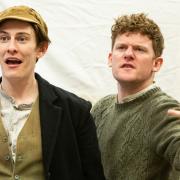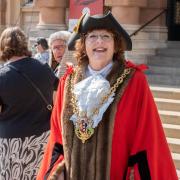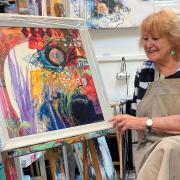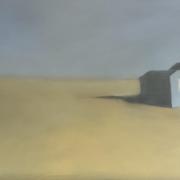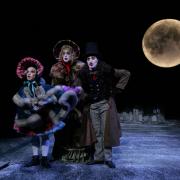October . . . the month for the unusual and the unexplained. Pip Wright delves into Suffolk’s strange, bewildering history of witchcraft
In April 1890, an inquest was held at Fressingfield into the death of Edith Margaret Hammond, who, at just 11 weeks old, mysteriously died soon after her grandmother had also passed away.
The Daily News reported: "This woman died a few hours before the child, and stated that the child would not live long after her. The father stated that he saw smoke issue from the perambulator and that the child died upon being taken home, the mother stating that it was hot and dry and smelt of brimstone.
"George Corbyn, the child's grandfather, said he was of opinion his late wife had the powers of a witch and he always tried to do what she wanted in consequence."
At the time of the incident, it was more than 150 years since the law had been changed to stop the persecution of witches. But old habits and beliefs die hard.

The history of witchcraft in Suffolk is a dark story of suffering, persecution and death, reaching into the hearts of families and communities, and creating fear and hysteria that persisted even until recent times.
Throughout the Middle Ages, white witches, working as herbalists and midwives, enjoyed the mysticism that surrounded them. Even kings took their advice.
One of the earliest tales is of Margery Jourdemaine, The Witch of Eye, who was tried in 1441 with Thomas Southwell and Roger Bolingbroke, accused of using sorcery to know the date of the death of Henry VI. (He was just 20 at the time and lived for another 30 years).
Margery was burned for treason, while her more noble accomplices were hanged, drawn and quartered. She couldn't have been tried for witchcraft because there was no law prohibiting it. Magic was merely a cause for wonder and very much accepted in this part of the world.

It wasn't until 1563 that the Witchcraft Act fully appeared on the statute books. Even this didn't link witchcraft with the devil or with religious heresy, but only condemned to death those who committed murder.
While the rest of Europe burned witches, the 1563 Act only prescribed death by hanging for those "who shall use practise or exercise any witchcrafte, enchantment, charme or sorcerie whereby any person shall happen to be killed or destroyed". Lesser witchcraft offences were punishable by up to a year's imprisonment and a spell in the pillory.
In one early Suffolk trial, Oliffe Barthram, of Stradbroke, was accused at Bury Assizes by witnesses, including the parish constable and the vicar, who testified that she had sent a spirit, in the form of a cat called Gyles, down the chimney of one Joan Jordan, to kill her.
It was also claimed that she had killed an unborn child by "nipping out his brains". She was found guilty and hanged at Bury on July 12, 1599.

Sink or swim
When James I became King of England in 1603, he brought a deep hatred of witches, and had already published a book on the subject, Daemonologie. From 1604 the law intensified. To hang you no longer had to be guilty of murder by way of sorcery, merely attempting to conjure spirits was a capital offence.
To bring a witch to trial there had to be witnesses, the more the merrier. And there was nothing like a confession to secure a conviction, though how some confessions were obtained was a concern, even back then.
It was useful to be able to show that a witch had been marked by the devil as belonging to him, with places on the body where the witch could not feel pain. 'Prickers' were employed, who used a variety of knives and probes to test their victims for 'devil's marks'.

And there were the 'tests'. One involved weighing the so-called witch against the big Bible in the parish church. If the Bible was heavier, it proved guilt. But the most famous test was to 'swim' your suspected witch.
Trussed crossways, the right thumb tied to the left big toe, and the left thumb to the right big toe, the suspect was ducked in water, as prayers were spoken. If she sank she was innocent, if she floated she was guilty, a sign that the water of her baptism was rejecting her.
As more and more witches were brought to trial, the public looked for protection against such evil, turning to the church, or to people offering protective remedies. It was said 'cunning men' could sell you a witch bottle to protect your home and family, and Bellarmine bottles, with their distinctive bearded faces, seemed designed for the purpose.
Recent scientific examination of several found buried under floors of old houses has shown the typical contents to have been iron nails, pins, pointed sticks, human hair, nail clippings and phosphates, denoting the presence of urine.

Renovations of old buildings have yielded all manner of good-luck charms in walls and chimneys, such as mummified cats, silver coins, shoes and horse skulls - even witches' brooms. It's interesting how many have been put back. Well, you never know...
Horrible Hopkins
The 17th century was a confusing time of social and religious change, civil war and the infamous Matthew Hopkins, self-styled Witchfinder General. Hopkins travelled East Anglia, earning a comfortable living finding and bringing to trial hundreds of witches in six counties.
His team specialised in extracting confessions from unfortunate individuals who they had been paid to find and bring to trial. In the summer of 1645, Hopkins swept through Suffolk, bringing to trial at least 117 'witches' and 'wizards'. Just 17 of those tried were men. Three married couples were also indicted.

Parishes in Suffolk where the number of witches tried at assize totalled four or more were Framlingham (10), Halesworth (8), Bramford (6), Ipswich (6), Copdock (4), Hintlesham (4), Chattisham (5) Rattlesden (5), Stowmarket (5), Wickham (5), Bacton (4), and Glemham (9). Another seven were hanged at Aldeburgh.
In such Puritan times, the explicit sexual content of trials shocked and excited Suffolk people. Elizabeth Southerne, of Dunwich, claimed that another witch, Mother Collit, had sent the devil to her in the form of a crab.
Climbing into her bed, he had nipped her and drunk her blood, so sealing a covenant and promising to provide for her. She claimed he lay with her a number of times after that, in different forms, once as "a hairy black boy", just 10 years old.
The confession of Margaret Bennet, of Bacton, said: "The devil in the shape of a man, carried her body over a close into a thicket of bushes and there lay with her, and after scratched her hand with the bushes and took her hand into his hand and writ upon a black patch, but she knew not what."

It's been suggested that at least 60 of Hopkins' victims were hanged, though this is probably a bit of an exaggeration. Several found guilty seem to reappear later in parish records. One of his victims was Mary Lakeland, who was burned after confessing to bewitching her husband who lay in great misery until his death. Witches were almost never to death.
What made this case special was the murder of a husband. Classed as petty treason, it carried the penalty of being "burned to ashes".
Another notorious case was 80-years-old Reverend John Lowes, who after 48 years as vicar at Brandeston, was not a popular man.
By all accounts, Hopkins kept Rev Lowes awake for several nights, after which his men ran him up and down the room until, exhausted and caring little for life, he confessed to sending his imps to sink ships between Yarmouth and Winterton, and causing "the child of Nathaniel Mann to languish and die". He was among at least 19 witches hanged at Bury St Edmunds on August 27, 1645. Newspapers were sold detailing their crimes and convictions.

Hopkins picked on the most vulnerable members of society, but his credibility was short-lived. One or two high profile cases left a bad taste in the mouth, and he left a mountain of resentment when he moved on to Norfolk and Cambridgeshire.
By the end of 1646, he was welcome nowhere, and ceased his witch-finding activities. The Hammer Horror film, Witchfinder General (1970), filmed in Suffolk, would have us believe that he came to a gruesome end. It's far more likely that, suffering from tuberculosis, he returned home where he died.
Though the trials continued, more enlightened judges persuaded even the most superstitious jurors to question what was being presented as 'evidence' in their courts. In the spring of 1694, Sir John Holt heard a number of indictments against Phillipa Munnings, of Hartest, including three accusations of "bewitching to death".
It was claimed she had threatened her landlord, Thomas Pannell, "Thy nose shall lie upward in the churchyard before Sunday next", an unfortunate prediction, which turned out to be true. But she was acquitted of all charges, and protested her innocence right up to her own death two years later.

The last capital conviction in England for witchcraft was probably in Hertfordshire in 1712, but it wasn't until 1736 that former Witchcraft Acts were repealed, though not entirely removed from the statute books. Technically, you could still be imprisoned for practising witchcraft until 1951. Only then was the act finally abolished.
Read all about it
You can change the law with the stroke of a pen, but you don't change Suffolk people's opinions and beliefs that easily. On a loose paper at the end of the parish register of Monks Eleigh are the words, "Dec. the 19th 1748, Alice, the wife of Thomas Green, labourer, was swam, malicious and wicked people having raised an ill report of her for being a witch."
From the early 18th century, local newspapers were being published across East Anglia, which shows how attitudes had changed little in rural Suffolk, in spite of what had been prescribed at Westminster.

The Norwich Gazette of September 1752 reports: "By a letter from Woodbridge in Suffolk, we learn that the country people about Aspal Stonham in that neighbourhood are still so full of ignorance and superstition that they imagine there are several witches and wizards in that neighbourhood and they have tied up two or three old people in sheets with cords around their middles and flung them into the rivers to see if they could save themselves."
Both local and national press attended when a 67-years-old man was swum for a wizard at Wickham Skeith in front of hundreds of people.
According to the Suffolk Chronicle, of July 16, 1825: "Isaac Stebbings, earns a living as a huckster. As in former days of gross credulity and ignorance, someone or other put forth the surmise that two afflicted persons are bewitched, and Stebbings was spoken of as the worker of the mischief.
Besides this, the village shoemaker persisted that one morning, as Stebbings passed two or three times before his house, he could not "make" his wax - the ingredients would neither melt nor mix. Dubbed a wizard beyond all doubt, poor Stebbings, ignorant as his neighbours, and teased beyond bearing, proposed at length, of himself, the good old fashioned ordeal of sink or swim."

The article describes how his accusers attempted, without success, to get Stebbings to sink, keeping the poor old fellow three quarters of an hour in the pond until he came out "more dead than alive".
The Chronicle concluded: "Even now in the nineteenth century, a portion of the populace - perhaps a considerable portion - retaining the foolish prejudices of their forefathers, believe that there are witches and wizards still.' Isaac Stebbings lived for another 22 years.
The Star of the East, June 15, 1886, reported: "Witchcraft at Framsden - The greatest excitement has been caused in the unusually quiet village of Framsden by a report that has got about among the labouring classes that a young girl living on the road from Otley to Framsden has been bewitched.
"It seems that the girl has been subject to periodical fits. Large numbers of people have nightly congregated at the cottage to witness the spiritualistic manifestations which accompany the fits. These are said to consist of violent twitchings of the bed furniture and supernatural knockings on the wall."

Across East Anglia, 19th century papers carried countless tales of burning effigies, hauntings, and even mob-justice. The famous Hedingham witchcraft case recorded how, in 1864, Emma Smith, of Ridgewell, and Samuel Stammers, of Sible Hedingham, in Essex, would eventually be charged with causing the death of an old disabled man known as Dummy. Thinking him to be a sorcerer, the two ring-leaders assembled a crowd and attempted to swim him in a stream.
Dummy never recovered from his ordeal and died a month later. The pair were found guilty of manslaughter and sentenced to six months of hard labour.
The East Anglian Miscellany of 1904, reported: "In Stowmarket, we have a woman who is said to have inherited the gift from her mother, who cuts for the spleen, an imaginary affection.
"The woman cuts the back of the ear slightly with a razor, dips her finger into the exuding blood, marks the forehead with the sign of a cross, mutters an incantation, puts a plaster of the expressed oil of mace upon the pit of the stomach, orders them to chew rhubarb root before each meal, and the spleen will be cured. She charges a fee of 5s, an important factor in the treatment."
And still, such beliefs held good. Local newspapers in September 1904 published the following case from Bottisham, near Cambridge. "Last year, a wood merchant aged only 27 was imprisoned for cruelty to his three horses. He thought they had been bewitched by an enemy, and to remove the spell he gave them a broth which he made by boiling some nails, a penny worth of pins and pieces of a horse's hoof over a fire with incantations.
"It is by no means improbable that this native of civilised England has occasionally dipped his coin into the missionary's bag to help convert the heathen in his darkness."
We read such accounts with a mixture of horror and amusement. But even today, stories appear from time to time that show belief in forces of the occult is very much alive and thriving in parts of Suffolk.
Suffolk witches
Pip Wright is a retired primary school teacher, living in Stowmarket who writes local history books and gives talks to groups across East Anglia. He has spent years gathering information on Suffolk social history and his particular passion is newspapers of the 18th and 19th centuries.
He has produced several books and says he still has hundreds of more good stories he intends to publish. His book Whistlecraft is the true story of a notorious family of poachers from Rickinghall and is one of four historical novels written about local people.
The others are Lydia, Daniel Malden, and The Class of '63, a novel set around a charity school in Earl Stonham in 1763. pipwright.com
_______________




